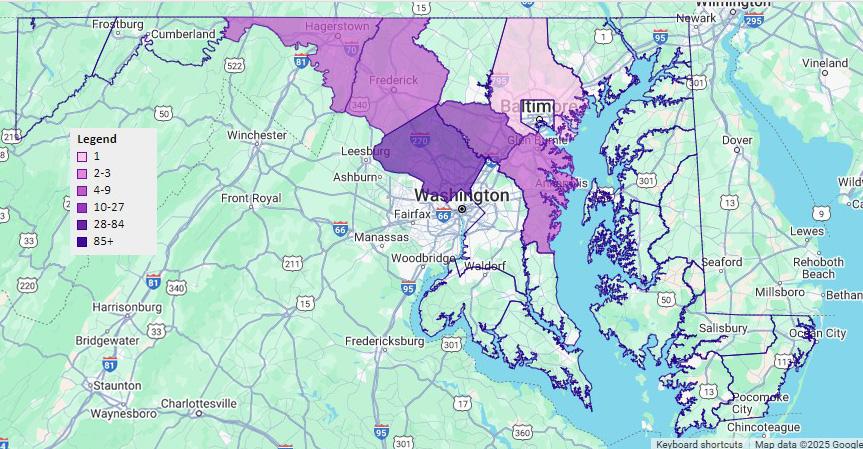From Winter 2025 issue of Branching Out. Subscribe to Branching Out here. Read more Invasives in Your Woodland articles here. This article contains information current as of date of publication.
The term “Incised fumewort” may not be familiar to many readers of this column, as this plant is a relatively new arrival to North America. It was first identified in the US only in 2005. Experts are unsure how it arrived. Some speculate that it was imported for garden planting; or arrived as seeds in contaminated imported garden materials. But one thing is for certain: its range is growing. By the time it was definitely identified as a non-native plant, it had already established a viable population that defied complete removal. Since then, new populations have been identified in Pennsylvania, Maryland, District of Columbia, Virginia, North Carolina, and as far west as Tennessee and Illinois. This issue’s map from the Maryland Biodiversity Project shows its reported concentration across the state (darker shades of purple represent greater concentrations).

from Maryland Biodiversity Project.
Consequently, this is an invasive plant species that has been causing concern in several states. In 2017, the USDA classified incised fumewort as a "high-risk" invasive species due to its potential to become widespread and cause significant ecological damage. Additionally, the Maryland Department of Agriculture estimates that approximately 37% of land in the U.S. could be suitable habitat for incised fumewort. Its population can potentially double in size each year, making it a rapidly spreading invasive species. The New York Botanical Garden calls it “the latest threat to our gardens, forests and wetlands.”
Consequently, this is an invasive plant species that has been causing concern in several states. In 2017, the USDA classified incised fumewort as a "high-risk" invasive species due to its potential to become widespread and cause significant ecological damage. Additionally, the Maryland Department of Agriculture estimates that approximately 37% of land in the U.S. could be suitable habitat for incised fumewort. Its population can potentially double in size each year, making it a rapidly spreading invasive species. The New York Botanical Garden calls it “the latest threat to our gardens, forests and wetlands.”
What is it?
Incised fumewort (Corydalis incisa) is an biennial herbaceous spring ephemeral plant in the poppy family. It is a shade-tolerant, low-growing plant (less than 2 feet tall). Native to Asia, it was first detected in the U.S. in the Bronx, NY in 2005. This plant can form dense carpets along forest floors, woodlands, and riparian areas, suppressing and outcompeting native species, such as Virginia bluebells.
How does it spread?
Incised fumewort has several effective mechanisms for dispersal. The plant produces oblong seed pods that can explosively eject seeds up to 10 feet away when disturbed by movement or weather. Its seeds can also spread by flowing water and by ants; they contain a protein and fat-rich structure that attracts ants. Humans may also contribute to the spread by using contaminated nursery materials and by transporting contaminated soil.
How can I identify it?
Incised fumewort can be identified first by its low-growing habit. The compound leaves have a resemblance to parsley, are divided into three leaflets, which are further subdivided into three smaller leaflets. The leaves themselves are highly serrated, lobed, or incised (hence the name). In the mid-Atlantic, it begins growing in February as stems from tubers, with purple flowers emerging from March though early May. The pod-shaped fruits form shortly thereafter. The first seeds disperse about three weeks after the first flowers. See the photo gallery below.
It is essential to distinguish it from the native yellow fumewort (Corydalis flavula). The invasive has purple flowers instead of yellow, more heavily divided lobed leaves, and up to 200 teeth on one leaflet, compared to no more than 90 on the native species.
How can I control it?
The best way to control incised fumewort is to hand pull and dig out second-year or older plants, ensuring removal of the small tuber. Avoid hand-pulling first-year individuals, as the tuber may break off and lead to further spread. Mowing several times throughout the growing season to suppress growth and prevent seed setting. Apply a foliar spray of a 3% solution of glyphosate; exercise caution when applying herbicides near wetlands or floodplains to minimize non-target impacts.
For more information:
Learn more about incised fumewort:
Have You Seen Incised Fumewort? (Maryland Grows Blog)
An Incisive Invader (Maryland Invasive Species Council)
Invasive Plants: Emerging Invasive: Corydalis incisa (Research Guides at New York Botanical Garden)
